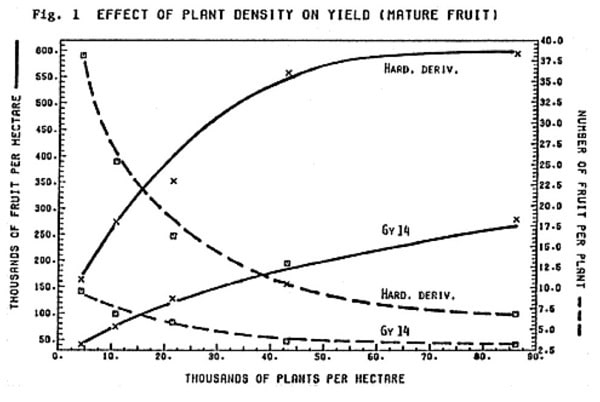Cucurbit Genetics Cooperative Report 6:3-4 (article 1) 1983
D. E. Delaney, R. L. Lower and M. D. Edwards
University of Wisconsin, Madison, WI 53706
Cucumis sativus var. hardwickii has great potential as a source of germplasm for improving yield of pickling cucumbers. It is unique in that it sets large numbers of seeded fruit, and seems to lack apical dominance, producing more and longer laterals than lines of C. sativus. Under North Carolina conditions it averaged 80 fruit and 11.4 laterals per plant on a 0.6 m within row spacing (1). Previous studies have evaluated several morphological characteristics of C. sativus var. hardwickii at different within row spacings (2). Decreasing within row spacing had no effect on either main stem length or number of nodes on the main stem, but it did significantly decrease number of lateral branches. The objectives of this study were to compare the effect of within row spacing on fruit number per plant at maturity and to evaluate the potential usefulness of C. sativus var. hardwickii germplasm in commercial settings.
All plots were seeded in July of 1982 at the Hancock, WI Experiment Station in a completely random design with five replications. Within row spacings were 8 cm, 15 cm, 20 cm, 61 cm and 1.5 m. There were 1.5 m between rows. Plant material consisted of three open-pollinated C. sativus var. hardwickiiderivatives and Gy 14, a gynoecious inbred of C. sativus. The hardwickii derivatives were from a random mating block of hardwickii material that was started in 1978. This germplasm had about 20% selection pressure for mature fruit yield and has been increased in each subsequent year. The derivatives were very heterogeneous and thus were not true breeding in terms of harvest date or numerous other characters. For this reason, a mature fruit harvest was chosen as the best index of fruit yield. Mature fruit count per plot was taken in September when the plants had stopped growing.
The C. sativus var. hardwickii derivatives consistently outyielded Gy 14 at all within row spacings (Table 1). Significant differences in fruit number per plant were not only found between the hardwickii derivatives and Gy 14, but also between the individual derivatives. At the two highest plant densities, hardwickii derivative #1 was significantly higher yielding than derivatives #2 and #3. Mean fruit number per plant for the hardwickii derivatives decreased greatly as plant density increased from 4,300 to 43,000 plants per hectare, while on Gy 14 the decrease was more gradual (Fig. 1). The same is true for fruit number per hectare. On the hardwickii derivatives, mean fruit number per hectare increased greatly as plant density increased to 43,000 plants per hectare, but then leveled off. On Gy 14, however, fruit number per hectare increased linearly as plant density increased.
Although fruit numbers on C. sativus var. hardwickii derivatives decline rapidly as plant population increases, they are so much higher than standard C. sativus cultivars that the potential for increasing yield is still great. Also, as is indicated by the highly significant interaction between lines and within row spacings (Table 2), lines perform differently at varying plant densities. In fact, hardwickii derivative #2 did not show the same leveling off of fruit number per hectare as plant density increased, but was continuing to increase steadily up to 86,000 plants per hectare. Thus, it may be possible to extract lines that are not as sensitive to high plant populations, yet are still higher yielding than the standard C. sativus cultivars currently available.
Table 1. Mean mature fruit numbers per plant for three C. sativus var. hardwickii derivatives and Gy 14 at five different within row spacings.
Within-Row Spacing |
|||||
Line |
8 cm |
15 cm |
30 cm |
61 cm |
1.5 m |
| C. s. var. hardwickii #1 | 8.19c | 17.02c | 17.25b | 27.56b | 39.32b |
| C. s. var. hardwickii #2 | 6.14b | 9.24b | 14.61b | 22.45b | 37.96b |
| C. s. var. hardwickii #3 | 6.37bc | 12.54b | 17.16b | 26.32b | 37.04b |
| Gy 14 | 3.24a | 3.61a | 5.94a | 6.92a | 9.63a |
| LSD (.05) | 1.85 | 4.22 | 3.55 | 5.89 | 9.31 |
Table 2. Analysis of variance for mature fruit number per plant between GY14 and three C. sativus var. hardwickii derivatives.
Source |
df |
Mean Squares for Mature Fruit No./Plant |
| Line | 3 | 1298.2** |
| Within row spacing | 4 | 1907.4** |
| Line x within row spacing | 12 | 123.8** |
| Error | 80 | 17.9 |
**Significant at the 0.01 level.

Figure 1. Effect of Plant Density on Yield (Mature Fruit)
Literature Cited
- Horst, E. K. 1977. M.S. thesis. Department of Horticultural Science, North Carolina State University.
- Horst, E. K. and R. L. Lower. 1978. Cucumis hardwickii: a source of germplasm for the cucumber breeder. Cucurbit Genetics Coop. Rpt. 1:5.